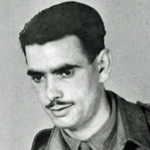'British Military Mission 204'
Mission 204 was the designation given to the British Military Mission to China.
Photos of the Special Service Detachments, British Military Mission 204 to China.
An account from the Australian War Museum of Australian involvement in Mission 204.
Special Service Detachment 1
A detachment (SSD1) taken from British Military Mission 204 for use in operations in Burma.
Special Service Detachment 2
A detachment (SSD2) taken from British Military Mission 204 for use in operations in Burma.
ENGLISH, R.W. Major, Letter on Mission 204
Transcript (by Elaine Southworth-Davies) of a letter from Major R.W. English in response to an enquiry from Kevin O'Marah about the war service of his father WO1 Andrew O'Marah.
"April 15. 1984
Dear Mr O’Marah
I am writing in response to your request in the Legion under “Lost Trails” for information concerning the British Military Mission to China (204 Mission).
I was with the Malayan Contingent which arrived in Burma (Maymyo) when the Bush Warfare School was opened in 1941. During the first few weeks we were joined by the other Contingents which made up 204 Mission. These Contingents came from Middle East (Commando Units) Australian Infantry Units (Malaya ) Far East (Hong Kong) and ourselves of course, drawn from Infantry and R E Units etc., Malaya.
After several months training and following the outbreak of hostilities with Japan the Mission left for China as planned. Those left behind in Burma were to eventually reinforce the Mission as and when required. However, in the light of the events that followed those remaining were eventually absorbed into the Burma Forces and it is at that time that No. 9 Independent Coy. and the Special Service Battalion must have been formed.
As for ourselves, we stayed in China for about twelve months and eventually were flown out to India. Not having really done an awful lot, most of us came out sick and when fit again joined other Units such as Wingate Forces. With a number of others, I later joined Force 136.
I cannot recall your father but certainly have still a vivid recollection of those days in Maymyo and, having been there from the very early days, may be able to assist you if you should require information on any specific details. If so, please let me know.
Yours sincerely
(signed)
R. W. English, Major "
Follow this link to view our Images of Mission 204 and the Special Service Detachments.
Mission 204 letter from IWM
Transcript (by Elaine Southworth-Davies) of part of a reply dated 23 January 1985 from the Imperial War Museum (ref CJVH/ES/074472) to Kevin O'Marah in response to his enquiry about the war service of his father WO1 Andrew O'Marah.
"Dear Mr O'Marah
Thank you for for your recent letter, your father appears to have had an eventful war career.
Mission 204 was the designation given to the British Military Mission to China as can be seen from the extract below:
" In discussing the forces available for the defence of Burma, mention has been made only of the troops actually in the country, but arrangements existed for military assistance from China in the event of a Japanese attack. Shortly after Far East Command had been set up in November 1940, Major-General L.E. Dennys was appointed Military Attache in Chungking with a view to his becoming the head of a British military mission in China (known as 204 Mission) should war break out.
Largely owing to his work and that of Wing Commander J. Warburton (Air Attache), British relations with the Chinese were satisfactory, and considerable progress was made in plans for mutual co-operation. These included a visit in April 1941 by a Chinese military mission to Burma and Singapore.
British assistance took the form of aid in the preparation of airfield sites in the Kunming area for the protection of the Burma Road and the despatch of stocks of explosives, aviation petrol bombs and other material to China. In addition, special squads of British and Indian personnel were put under training in Burma for eventual attachment to the fifteen Chinese guerrilla companies which were being formed in China. It was proposed ultimately to double the number of these companies and consequently, that of the special squads. The Chinese on their part promised to send troops into Burma if required, and to to threaten the Japanese northern flank should they advance against Burma by way of Chiengrai."
which was taken from The War Against Japan, Volume 2, India's Most Dangerous Hour, by Major General S. Woodburn-Kirby (London HMSO 1958). A further extract relates to the outcome of the idea of the joint British Chinese commando units:
"Major-General Dennys, who commanded the mission at the outbreak of war had been killed in an air crash on the 14th March 1942. His place was taken by Major-General J. G. Bruce. The latter recommended the withdrawal of the small British contingents in China since they were not being properly used by the Chinese. They were withdrawn by October 1942 and in November General Bruce handed over the command of the mission to Major-General Grimsdale, who was at that time British Military Attache in Chungking."
Follow this link to view our Images of Mission 204 and the Special Service Detachments.
STUART, Ted, Memories of 5 Commando and Mission 204

A personal account of the memories of Ted Stuart, No 5 Commando, who volunteered for Mission 204.